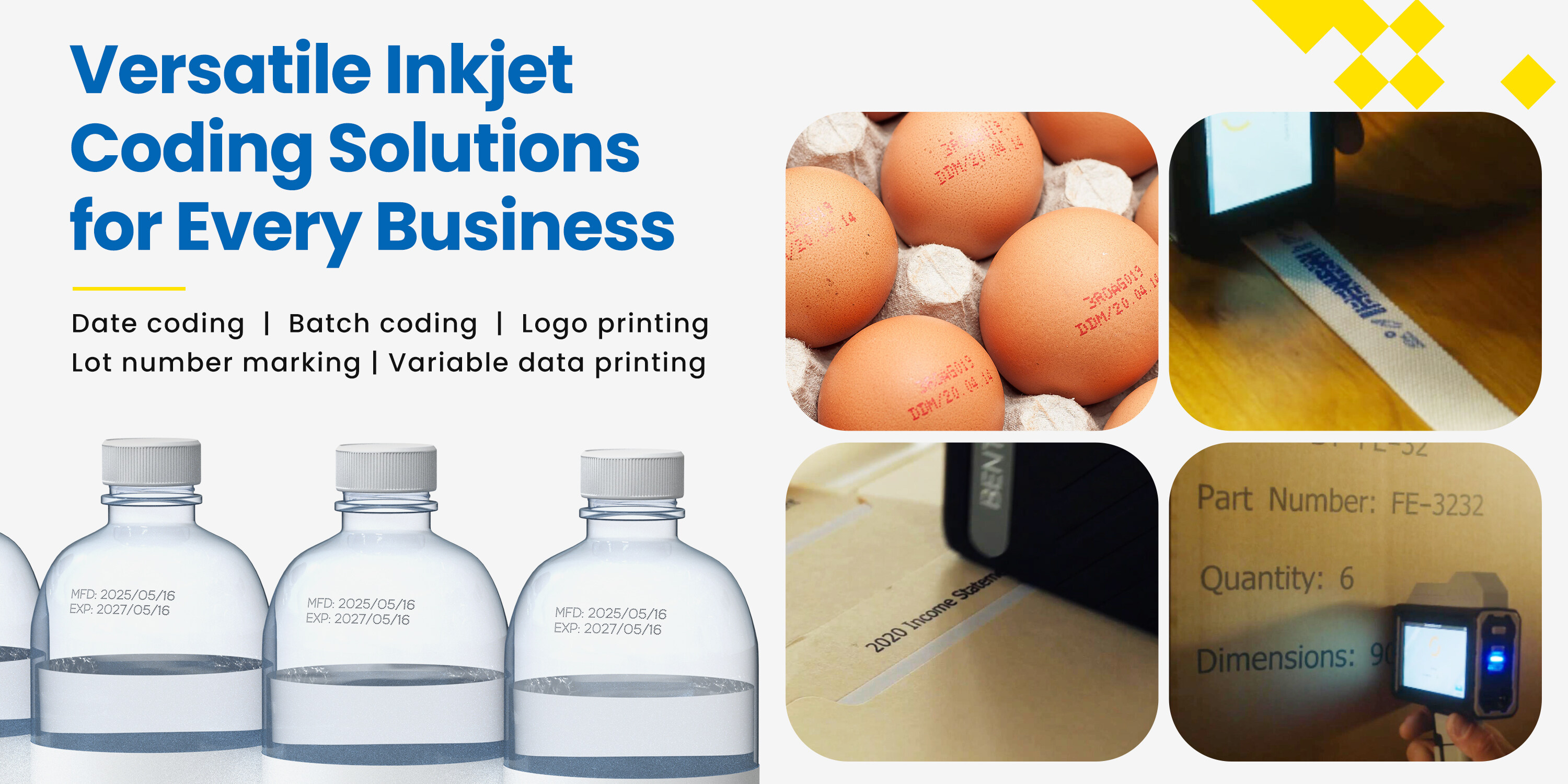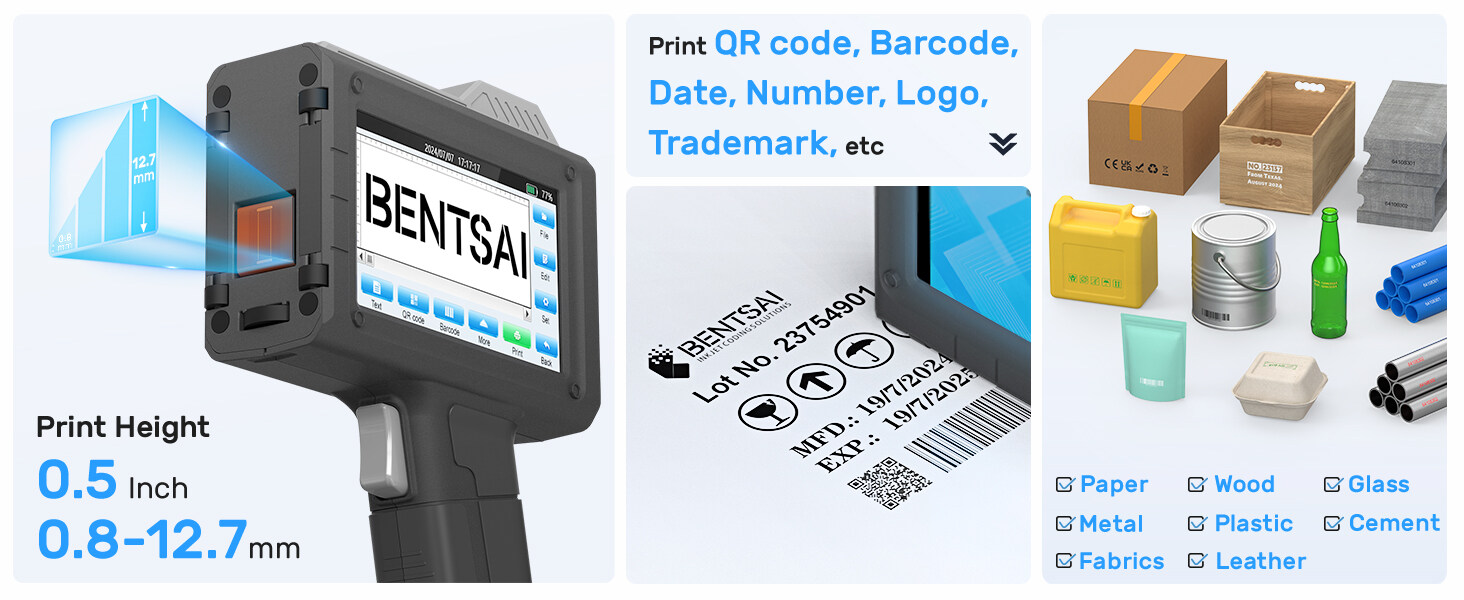Essential Guide: How to Choose a Good Batch Coding Machine
Batch coding is a critical process for businesses to mark products with essential information like manufacturing dates, expiry dates, lot numbers, and batch codes. These codes ensure traceability, compliance with regulations, and efficient inventory management. Whether you're producing food, pharmaceuticals, or electronics, batch coding helps quickly identify defective products during recalls, maintain quality control, and meet legal requirements.
About Batch Codes
What Is a Batch Code?
If you have read our previous articles, you should have a basic understanding about what is a batch code. A batch code (or lot number) is a unique combination of letters, numbers, or symbols printed on product packaging. It typically includes details like the production date, facility location, and batch sequence. For example, a code like "EXP2025-03" might indicate an expiry date of March 2025, while "LOT#1234A" could represent a specific production run. This code helps traceability, quality control, and recall management.

Why is Batch Code So Important?
● Quality Control & Traceability: Batch codes allow manufacturers to track products through the supply chain. If a defect occur, companies can identify the affected batches and effectively initiate recalls, minimizing risks to consumers and brand reputation.
● Regulatory Compliance: Many industries, especially food, pharmaceuticals, and cosmetics, are subject to strict regulations. Batch coding is often a legal requirement to ensure product safety and traceability.
● Inventory Management: Codes help warehouses and retailers manage stock rotation (e.g., “first-expired, first-out”) and reduce waste.
● Anti-Counterfeiting: Unique batch codes deter counterfeit products by enabling authenticity verification.
● Consumer Trust: In today's consumer-center market, trust is a precious commodity. Batch codes contribute to building and maintaining consumer trust by providing transparency about product origin and quality.

Which Businesses Need Batch Codes?
Batch codes have become a regulatory requirement in some industries. However, not all businesses use them because they are a requirement. Some businesses use them simply because they promote traceability, monitoring dates, and recall management, to ensure product quality and consumer safety. Given the importance of batch codes, it's essential to understand which businesses rely on them.

Batch coding is essential for the following industries:
- Food and Beverage Industry: To track expiry dates and allergens.
- Pharmaceuticals Industry: For drug safety and compliance.
- Cosmetics Industry: To monitor shelf life and ingredient batches.
- Electronics Industry: For warranty tracking and component recalls.
- Chemicals Industry: To manage hazardous material batches.
- Retail Industry: To manage inventory more effectively.
Even small businesses benefit from batch coding to build consumer trust and streamline operations.
What Factors Should Be Considered When Choosing a Batch Coding Machine
1. Printing Technology
- Inkjet Technology: Inkjet batch coding machines are highly versatile. They can print on a wide range of substrates, both porous and non-porous. They are known for their ability to create high - resolution, detailed codes, making them suitable for industries where the code needs to be scannable and clearly legible.
- Laser Technology: Laser coding machines offer permanent and durable markings. They are ideal for high volume production environments where the code needs to withstand harsh conditions, like in the automotive parts manufacturing industry. The laser - etched codes are resistant to abrasion, chemicals, and high temperatures.
- Other Technologies: There are also thermal transfer and dot-matrix technologies. Thermal transfer is good for printing on labels, providing clear and smudge-free codes. Dot-matrix, while a bit more basic, can be cost effective for simple coding needs in low volume production.
2. Machine Type
- Handheld Printers: Handheld batch coding machines are extremely Portable and perfect for small businesses or irregularly shaped items. More and more business choose a handheld inkjet printer for batch coding, as they can be easily carried around and used to code products directly on the production line.
- Traditional (Stationary): Traditional stationary machines are more suitable for high - volume, fixed - location production lines. They are often integrated into the manufacturing process and can code products at a high speed, ensuring efficiency in large - scale production environments.
3. Printing Method
- Contact Printing: Contact printing methods, like tamp - pad printing or hot stamping, involve physically pressing an inked or heated stamp onto the product surface. This method is good for creating bold, sharp codes on flat or slightly curved surfaces. However, it may not be suitable for delicate or irregularly shaped products.
- Non-contact Printing: Non-contact methods, such as inkjet and laser, do not require physical contact with the product. This makes them ideal for fragile products or those with complex shapes. They can also be used to print on moving products, increasing production speed.
4. Substrate Compatibility
Ensure the printer and ink works on your materials—porous or non-porous. If you are dealing with products such as cardboard boxes, paper labels, or wooden crates, you need a coding machine that can handle porous materials well. Inkjet printers using water-based inks are a good option.
For materials like plastic, metal, glass, or smooth-surfaced synthetic materials, the coding machine must be able to make the code adhere effectively. Inkjet printers with quick drying inks or laser printers are both great choices.
5. Durability & Maintenance
When selecting a batch coding machine, it is advisable to opt for models with low maintenance requirements. Machines that are durable and require minimal upkeep can save your business both time and money in the long run.
6. Print Resolution
A high-resolution coding machine is essential if you need to print complex barcodes, QR codes, or small text. A minimum resolution of 300 DPI (dots per inch) is recommended for most applications, but for industries with strict scanning requirements, like the medical device industry, a resolution of 600 DPI or higher may be necessary.
7. Variable Data Flexibility
The ability to print variable data is a must for most businesses. You should be able to change the batch code, date, time, and other relevant information easily. Modern batch coding machines often come with software that allows for easy data input and customization.
8. Cost-Effectiveness
Consider not only the initial purchase price of the coding machine but also the long - term costs. This includes the cost of consumables like ink, toner, or stamps, as well as maintenance and repair costs. Some machines may have a higher upfront cost but lower long-term running costs due to their efficiency and durability.
Which inkjet printer does BENTSAI recommend for batch coding?
All BENTSAI's inkjet printers are recommended for batch coding, as they are designed to meet different working environments and printing needs. BENTSAI offers various models of printers that can handle printing tasks with heights of 0.5 inch, 1 inch, 2 inches, and 4 inches respectively. Customers can make their choices according to their specific requirements. Today, we are bringing one of the most standout models for small-scale batch coding needs to the recommendation - the BENTSAI BT-HH6205BL handheld printer. Here are the reason why:
- Ultra-Fine Printing, 600DPI High Precision: With a print height of 0.8mm-12.7mm and the ability to print up to 600 DPI, the BT-HH6205BL handheld printer is ideal for small, detailed text and batch codes, ensuring sharp and clear results.
- Lightest Handheld Printer in BENTSAI's History: Weighing only 410g, it’s easy to carry and operate, reducing fatigue during extended use.
- Extended Battery Life: Equipped with a high-capacity battery, it provides up to 16 hours of continuous operation, twice the runtime of other models in the market.
- Variable Database Printing: Seamlessly print dynamic data such as serial numbers, barcodes, QR codes, and batch numbers without manual input.
- Versatile Printing Capabilities: It has the remarkable ability to print on a wide range of materials, including paper, plastic, metal, and even curved surfaces. This versatility makes it suitable for various industries
- High Efficiency: The printer uses fast-drying ink that ensures the printed codes are smudge-proof and waterproof. This is crucial in maintaining the clarity and readability of the batch codes. Additionally, the 6205BL handheld printer can be connected to a photoelectric sensor and set up on a conveyor line for auto batch coding, no more manual labeling for faster coding speed.

Conclusion
Batch code play a significant role across various businesses and industries. Choosing the right batch coding machine is important, and it depends on your industry, production scale, and material types. Handheld printers like the BENTSAI 6205BL offer flexibility for small businesses, while industrial systems suit high-volume needs. Prioritize durability, compatibility, and compliance to ensure your codes meet both operational and regulatory demands.
Ask Question
No questions and answers

